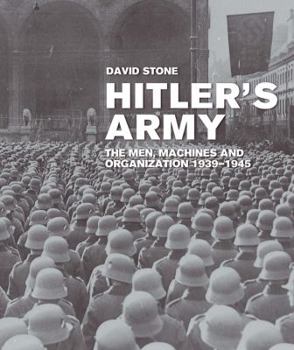Hitler's Army: The Men, Machines, and Organization: 1939-1945
Hitler's Army describes and analyzes every significant aspect of Germany's WWII ground forces including their creation, organization, weapons, equipment, training and tactics. This book also considers... This description may be from another edition of this product.
Format:Hardcover
Language:English
ISBN:0760337500
ISBN13:9780760337509
Release Date:September 2009
Publisher:Zenith Press
Length:288 Pages
Weight:3.85 lbs.
Dimensions:1.0" x 9.9" x 11.9"
Customer Reviews
2 ratings
A dynamite reference
Published by Thriftbooks.com User , 14 years ago
Mr Stone has created a reference book that describes the development, organization, operational procedures, training, equipment, officers and soldiers of Hitler's Army from 1933 to 1945. This large volume consists of eleven chapters, a conclusion, a large appendix and glossary. To highlight the key ingredients of this book is beyond the scope of this review but there is a lot packed into this book and I'll just give a brief summary. The book begins with the long History of Prussian leadership and works its way to post WWI and the rise of Hitler, Nazism and his impact of rebuilding the Army and rearming the country from the depths of the Versailles Treaty. The author also briefly covers 16 campaigns of WWII that includes all fronts. The Eastern Front receives the most attention. To me, this was the weakest chapter in the book due to its briefness but the author does acknowledge in his introduction that it was unfortunate but out of this purview to enlarge it. The author moves on to describe the Structure of Military Power, including organization charts, Command and Control, auxiliary units and much more in this area. Officers and soldiers get their coverage and includes indoctrination, duty and discipline, training, doctrinal updates. Other chapters includes uniforms, personal equipment and weapons. A section is also included on Insignia, Decorations and Awards. To complete the narratives, there are photos of the uniforms, equipment and insignias. The weaponry includes a range from pistols, machine guns, rocket launchers to panzers. There are over a hundred photos that support this text. The photos of insignias and decorations are close up shots and are quite revealing. There are also a few illustrations like an exploded view of a stick grenade. In addition to the Rifle and Panzer Divisions, a special section covers the supporting services that includes logistics to reconnaissance to engineering to intelligence. Another chapter includes Tactics and Special Operations and includes both offensive, defensive, delaying and withdrawal techniques. It includes airborne, mountain, winter, desert, amphibious and counter-partisan warfare. The narrative ends with the demise of the Wehrmacht and the Third Reich. There is also an extensive Appendix which includes information on the Wafen SS. It also has summary tables of the key weapons and equipment. A German-English Glossary is also included. A Notes section, Bibliography and Index close out the book. I've just scratched the surface; there is a lot to this book and its done well. I hope Mr Stone will do a sequel on the American, British and Russian Armies; it would make an excellent collection.
HITLER'S ARMY: THE MEN, MACHINES, AND ORGANIZATION 1939-1945
Published by Thriftbooks.com User , 15 years ago
HITLER'S ARMY: THE MEN, MACHINES, AND ORGANIZATION 1939-1945 DAVID STONE ZENITH PRESS, 2009 HARDCOVER, $40.00, 288 PAGES, PHOTOGRAPHS, MAPS, DIAGRAMS, CHARTS, GRAPHS, APPENDICES The Landser may not have represented the cutting edge of military technology, but he was the muscle and sinew that provided the strength and exceptional staying power of the German war machine. Even at the height of the mechanized Blitzkrieg style of combat, most battles were eventually decided by a struggle of man against man, the fighting taking place in foxholes, ruined buildings and shattered woods in a desperate struggle to take or to defend contested ground. German infantry fought with impressive tenacity all through World War II, remaining effective even after their units had suffered heavy losses. Statistical analysis have concluded that German troops inflicted at least 50% greater casualties than they received, regardless of whether they were attacking or defending. It was the overwhelming Allied numerical advantage, together with total Allied air superiority in the later years of the war that eventually overcame the stubborn German infantrymen. In spite of those two Allied advantages, the German Army of 1939-1945 did enjoy some other significant advantages. The first was in the excellence of mits staff work. Its senior commanders had been largely members of the elite of the old Prussian Army, the Grosser Generalstab (Great General Staff). Even though the terms of the 1919 Versailles Treaty had forced its dissolution, its traditions lived on, and a new generation of first-class staff officers began to be produced when Hitler re-opened the old Kriegsakademie (War Academy) in Berlin in 1935. Clarity of thought and precision were the hallmarks of the German staff officer. Allied to this was the German system of conducting operations. In comparison with the British and U.S. armies, German subordinate commanders were given considerable latitude. The key was that they fully understood what their superiors were aiming to achieve and that all their actions were in furtherance of this purpose. Concise written orders and maximum use of radio during a battle enabled commanders to identify their individual critical points and to make considerable use of their own initiative. This concept of Auftragstaktik (mission-oriented tactics) was one of the major ingredients of the successful blitzkrieg campaigns of 1939-1941. Finally, the German soldier at all levels was imbued with the Fuhrer, or leadership, principle. This was an aspect of the training system which had been developed during the 1920s. Each soldier was encouraged to think two grades of command above himself. Consequently, if his immediate commander was put out of action, he was more than capable of immediately assuming his mantle and carrying on with fulfilling the mission. It was perhaps this, more than anything else, which kept the German Army as an effective fighting machine until the very last weeks of the war





